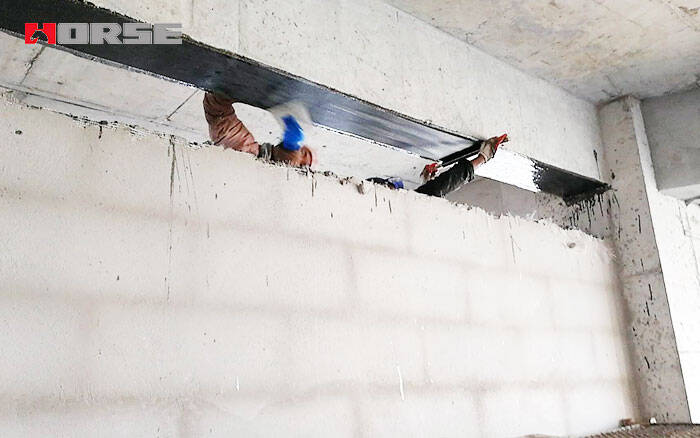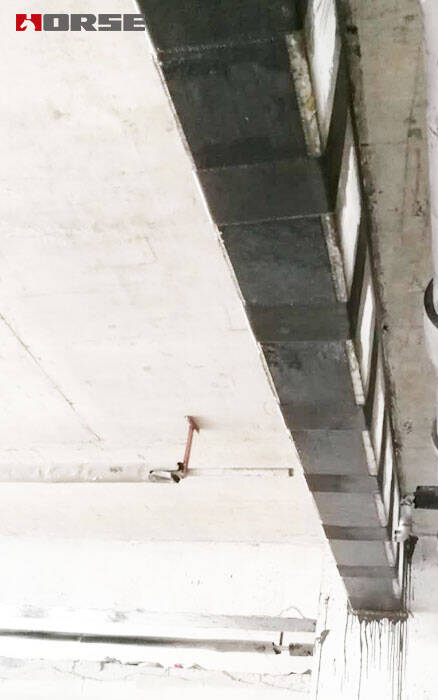Refuerzo de vigas de entramado en el primer piso
Nuevo complejo de locomotoras East Billion
Debido al cambio de función del edificio, aparecen pequeñas grietas tras el aumento de carga en la viga. Para garantizar la capacidad portante de toda la estructura, es necesario reforzar la estructura de la viga con polímero reforzado con fibra (PRFV).

Estudio de ingeniería
Nombre del proyecto: Nuevo proyecto Dongyi
Ubicación del proyecto: Condado de Nanjiang, Bazhong, Sichuan
Contenido de ingeniería: Reparación de grietas en vigas y vigas de hormigón reforzado con FRP
Razón
Debido al cambio en la función del edificio, aparecen pequeñas grietas tras el aumento de la carga sobre las vigas. Para garantizar la resistencia de toda la estructura, es necesario reforzar la estructura de las vigas con polímero reforzado con fibra de carbono (PRFV).
Tecnología de reparación de grietas y adhesión con polímero reforzado con fibra de carbono (PRFV)
Reparación de hormigón
Tratamiento de la base (limpieza de grietas): Pulido de las vigas con amoladora angular, revestimientos y mortero, utilizando un cepillo de alambre de acero para eliminar la superficie de las grietas. En caso de acumulación de polvo, se utiliza un soplador de alta presión para eliminar el polvo de las grietas y se limpia el polvo con un paño a lo largo de la grieta a ambos lados del hormigón.
Boquilla de lechado: La boquilla de lechado se aplica sobre la grieta con sellador. La boquilla de lechado de la base debe estar alineada con la grieta y el asiento inferior debe estar firmemente pegado sin fugas de pegamento. La separación entre las bases es de aproximadamente 20 mm a 30 mm, según el ancho de la grieta.
Grietas cerradas: Sellar todas las grietas con plástico, excepto la boquilla de lechado, con un ancho de 20 mm a 30 mm.
Dispensación: Verter el adhesivo en el dispensador y apretar el aplicador hasta el fondo.
Rellenado de adhesivo: Aflojar el dispensador, confirmar el estado de la inyección; si el adhesivo es insuficiente, añadir más adhesivo.
Finalización de la inyección: Una vez que se haya reducido la velocidad de inyección y no se haya añadido más adhesivo, retirar el adhesivo y tapar con el fondo de la lechada.
Una vez solidificado el adhesivo, retirar la base y el tapón y limpiar la superficie.
Después de limpiar la superficie, pulir las vigas y continuar con el siguiente procedimiento.

Refuerzo de fibra de carbono (PRFV) adherida
(1) Limpieza de la superficie de las vigas de hormigón
El hormigón deteriorado, como desconchados, desprendimientos, panal, protuberancias y corrosión, se elimina mediante una muela abrasiva eléctrica para exponer la capa estructural.
(2) Ubicación del alambre:
Según el diseño, el rango de refuerzo de PRFV debe trazarse con una línea de tinta, calibrada de arriba a abajo y delimitada según el tamaño de diseño desde ambos extremos del talón hasta la mitad. Si la división no es un número entero, se debe ajustar el espacio y el tamaño no debe ser mayor que el tamaño de diseño.
(3) Rectificado de superficies
La superficie del hormigón adherido con láminas de PRFV debe ser sólida. Tras eliminar las impurezas, como la capa de lechada y el acero inoxidable, el hormigón debe pulirse hasta obtener una lisura de 5 mm/m. El componente debe pulirse formando un arco fuera de la esquina pegada, con un radio mínimo de 20 mm. Una vez pulida la superficie, se puede eliminar completamente el polvo superficial con un soplador potente o un aspirador de polvo.
(4) Tratamiento de purificación
Tras adherir la superficie de fibra de carbono del hormigón a la superficie rugosa, se debe limpiar con hilo de algodón y acetona industrial.
(5) Tratamiento de nivelación
1. El material de nivelación debe asignarse de acuerdo con las normas técnicas proporcionadas por el fabricante del producto.
2. El material de nivelación debe utilizarse para rellenar la parte cóncava de la superficie del hormigón, evitando bordes y esquinas.
3. En la esquina, el material de nivelación debe repararse formando un arco circular liso con un radio mínimo de 20 mm.
4. Una vez que la superficie del material de nivelación esté seca, se debe proceder inmediatamente a la siguiente fase de construcción.
(6) Confección de tela de fibra de carbono
La tela de fibra de carbono se puede cortar con tijeras o cúter según los requisitos del diseño. Se debe garantizar la integridad de la fibra longitudinal de la tela de carbono. Se debe prohibir estrictamente doblar la tela de carbono cortada según el tamaño del diseño. La tela de carbono debe almacenarse recta para evitar deformaciones y deformaciones. No debe quedar cubierta de polvo ni manchas de aceite.
(7) Tela de fibra de carbono
1. El adhesivo de fibra de carbono debe prepararse según las normas tecnológicas del fabricante y aplicarse uniformemente sobre la pieza adhesiva.
2. La longitud de solape del CFRP a lo largo de la dirección de tensión no debe ser inferior a 200 mm, y las posiciones de solape de las láminas o laminados de CFRP deben estar escalonadas.
3. Se utiliza un tambor especial para rodar a lo largo de la dirección de la fibra varias veces para extruir burbujas, de modo que las posiciones de solape de las láminas de fibra de carbono queden escalonadas.
4. Los pasos anteriores deben repetirse en el pegado multicapa, y la capa inferior debe pegarse lo antes posible después de que el adhesivo de fibra de carbono sobre la superficie de la fibra de carbono se seque.
Inspección de calidad del proceso
(1) La tela de fibra de carbono debe estar limpia, sin arrugas, con una disposición de fibras uniforme y continua, sin hilos rotos, nudos, etc.
(2) La apariencia y el color del adhesivo de la tela de carbono deben ser uniformes, sin apelmazamiento ni precipitación estratificada.
Método de inspección: observación
(3) Inspección de la superficie después del lijado y el pulido.
Método de inspección: la regla de contacto debe ser lisa y tener un buen registro.
(4) La lámina de CFRP adherida debe estar completamente aplanada, sin arrugas ni burbujas de aire. El área de adhesión efectiva entre la lámina de CFRP y el hormigón no debe ser inferior al 95 % del área total de adhesión. El área de una sola burbuja vacía inferior a 10 000 mm² puede repararse mediante inyección. Los tambores vacíos con una superficie inferior a 10 000 mm² deben cortarse, repararse y volver a pegarse con tela de fibra de alta calidad. La longitud de la superposición multicapa no debe ser inferior a 150 mm.
(5) El adhesivo impregnado debe impregnarse en la superficie de la tela de fibra de carbono y, tras cepillar la superficie, debe quedar una superficie adhesiva más lisa.
Método de examen: Observación.
(6) Detección: Organismo nacional de pruebas reglamentarias, prueba antidesprendimiento, prueba destructiva e informe de prueba.